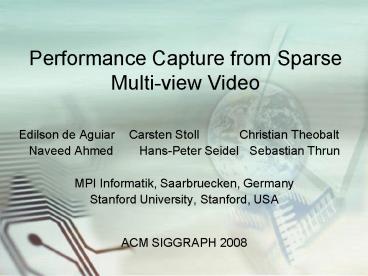Performance Capture from Sparse Multi-view Video - PowerPoint PPT Presentation
1 / 11
Title:
Performance Capture from Sparse Multi-view Video
Description:
Performance Capture from Sparse Multi-view Video Edilson de Aguiar Carsten Stoll Christian Theobalt Naveed Ahmed Hans-Peter Seidel Sebastian Thrun – PowerPoint PPT presentation
Number of Views:128
Avg rating:3.0/5.0
Title: Performance Capture from Sparse Multi-view Video
1
Performance Capture from Sparse Multi-view Video
- Edilson de Aguiar Carsten Stoll Christian
Theobalt - Naveed Ahmed Hans-Peter Seidel Sebastian Thrun
- MPI Informatik, Saarbruecken, Germany
- Stanford University, Stanford, USA
- ACM SIGGRAPH 2008
2
Introduction
- A new marker-less approach to capturing human
performances from multi-view video - Jointly reconstruct spatio-temporally coherent
geometry
3
Outline
- Introduction
- Pre-processing
- Capturing the Global Model Pose
- Capturing Surface Detail
- RESULTS
4
Pre-processing
- Take a full-body laser scan
- 8 cameras , 24fps , 1004x1004 pixels , placed in
circular - A coarser tetrahedral version Ttet
- Registered to the first pose of the actor
- in the input footage by ICP
5
Capturing the Global Model Pose
- Pair image features from time t
- Use SIFT feature descriptor
- A set
- pseudo-intersection point of the
reprojected rays
6
Capturing the Global Model Pose
- Temporal correspondence
- Leordeanu and Hebert 2005
- spectral analysis problem on a graph adjacency
matrix - Compute predicted 3D target position
- The best handle vertex vi is the one whose local
normal is most collinear with the difference
vector - A new intermediate target position
- Output
7
Capturing the Global Model Pose
- Re?ning the Pose using Silhouette Rims
- rim vertices it projects into close vicinity of
the silhouette contour in one of the Ck,t1 - Obtain deformation as same as page 6
8
Capturing the Global Model Pose
- Globally optimizing the positions until good
silhouette overlap is reached. - Choose 15-25 key vertices Vk ? Vtet manually
9
Capturing Surface Detail
- Ttet is mapped to Ttri
- check image gradient at the input silhouette
point has a similar orientation to the image
gradient in the reprojected model contour image - If distance between back-projection and original
position lt - Then add it as constraint to
10
Capturing Surface Detail
- To recover shape detail, such as folds and
concavities - multi-view stereo methodGoesele et al. 2006
- merge the depth maps produced by stereo into a
single point cloud P - project points from Vtri onto P Stoll et al.
2006. - provide additional position constraints for Eq(3)
11
Result
- 4 different actors
- Feature 200600 each
- After global pose estimation (blue)
- After surface detail reconstruction (green)
- Demo video































